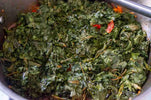
How to Make Lalo: Haitian Stewed Greens in 2025
, by Seo Guy , 4 min reading time

, by Seo Guy , 4 min reading time
Lalo is one of Haiti’s most beloved stews, known for its earthy, robust flavor and its use of leafy greens such as spinach and jute leaves. It is especially popular in the Artibonite region, where rice farming dominates and where Lalo is almost always served with white rice. The dish is hearty, nutrient-rich, and deeply tied to the land, reflecting Haiti’s agricultural roots and its ability to turn simple, natural ingredients into meals that feed both body and spirit.
In 2025, Lalo continues to stand as a cultural marker of Haitian identity. It is celebrated in homes across Haiti and abroad, often prepared on weekends or for family gatherings. For Haitians in the diaspora, cooking Lalo is a way of preserving heritage and passing traditions down through generations.
Lalo is primarily made with lalo leaves, which come from the jute plant, and spinach or other greens to balance the flavor. These leaves are simmered with garlic, onions, peppers, and epis, the signature Haitian seasoning blend. To this base, protein is added, most commonly crab, beef, or goat, giving the dish depth and richness. The stew is cooked slowly until the greens break down and meld with the flavors of the meat and spices.
What sets Lalo apart is its bold seasoning and earthy taste. The jute leaves, slightly mucilaginous when cooked, create a texture that is unlike other stews. Combined with spinach, they produce a layered green flavor that is hearty yet fresh. Served with rice, Lalo becomes a complete meal that satisfies both hunger and tradition.
Preparing Lalo is a time-intensive process, often requiring several hours. The leaves are carefully cleaned and chopped before being simmered in a pot with epis, garlic, and Scotch bonnet peppers. Meat is seasoned and browned separately before being added to the stew. Crab is a common addition, lending sweetness and complexity to the broth.
The dish is cooked low and slow, allowing the flavors to meld together. Families often prepare it in large pots, since Lalo is not a dish for one—it is meant to be shared. The finished stew is thick, aromatic, and deeply flavorful, served alongside rice that soaks up its richness.
Lalo is not just food; it is a social event. In Haiti, cooking Lalo often involves multiple people—washing the greens, preparing the seasoning, and tending the pot. The dish is strongly associated with Sundays, when families gather after church for long, leisurely meals. It is also tied to celebrations, symbolizing abundance and unity.
In the diaspora, Lalo retains its communal role. Families often gather specifically to cook it, even when sourcing jute leaves requires extra effort. For Haitians abroad, Lalo is more than nourishment—it is a taste of home that reconnects them with their roots.
Greens like jute leaves and spinach represent fertility, strength, and connection to the land. In Haitian food culture, they also symbolize resourcefulness, as families have historically relied on what the land provides to create filling and nutritious meals. Lalo embodies this tradition of making the most of local crops while elevating them into celebratory dishes.
While less known internationally than Soup Joumou or Diri Djon Djon, Lalo is beginning to gain attention as Haitian cuisine reaches wider audiences. Haitian chefs in cities like New York and Miami have started showcasing Lalo on restaurant menus, introducing non-Haitians to its unique flavor and texture. Food bloggers and cultural festivals are also bringing more visibility to the dish, framing it as a symbol of Haiti’s deep connection to its land and traditions.
In 2025, Lalo remains a dish that surprises and delights those who try it for the first time, expanding the global understanding of Haitian cuisine beyond its most famous staples.
Like many Haitian recipes, Lalo is passed down orally through families. Grandparents teach children the slow, careful process of preparing the greens, while parents emphasize the importance of seasoning and patience. The recipe may vary from household to household—some families prefer it spicier, others include more crab or goat—but its cultural role remains the same. It is a dish that connects generations, preserving memory and tradition in every pot.
Lalo is important because it showcases Haiti’s ability to transform humble ingredients into something extraordinary. It represents resilience, community, and cultural pride. In 2025, as global cuisine embraces health-conscious and plant-forward dishes, Lalo also appeals to those looking for meals that are both nourishing and authentic. It tells a story of Haiti’s agricultural richness while honoring the creativity of its people.
Cooking Lalo brings families together, but Haitian pride can also extend into everyday life. At CreoleSizzle.com, you can find Haitian-inspired kitchenware, apparel, and accessories that help celebrate culture beyond the table. Just as Lalo feeds both body and soul, CreoleSizzle keeps traditions alive and visible in your home and lifestyle.